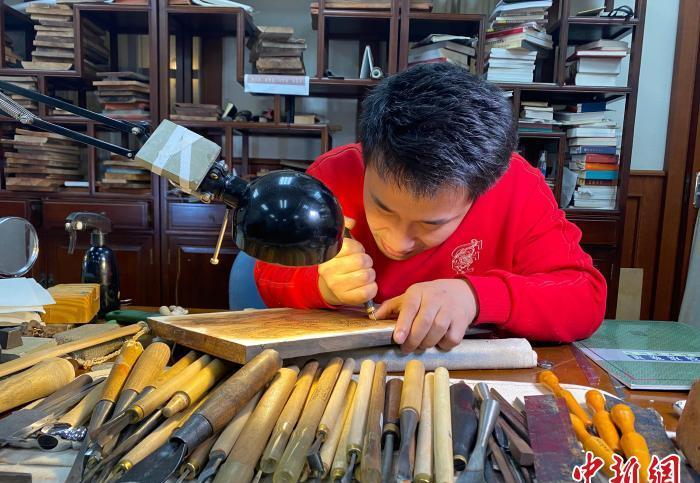
Li Zhenhao carved the tiger pattern on a tang pear wood board. Photo by Li Mingrui
(New Year to the grassroots) "post-90s" intangible cultural heritage craftsmen reproduce and print Qing Dynasty New Year paintings to explore the inheritance of vitality
Jinan, February 6, China News Network Title: "Post-90s" Intangible Cultural Heritage Craftsmen Reproduce and Print Qing Dynasty New Year Paintings to Explore the Inheritance of Vitality
Author Li Mingrui
Knife and wood collide, ink and paper blend, into the studio of Shandong engraving and printing craftsman Li Zhenhao, who is concentrating on carving different shades of lines on a tang pear wood board, gradually forming a complex tiger pattern.
Li Zhenhao told reporters that the New Year painting is a painting style unique to China. Every New Year's Day, every household posts New Year paintings to express their good wishes for blessings and good fortune. In the Year of the Tiger in the Chinese Lunar Calendar, he consulted books, flipped through the materials, and reproduced and printed a Painting of the Year of the Tiger in the Qing Dynasty in the form of engraving and printing.
Li Zhenhao carried out the steps of printing the Year of the Tiger Painting. Photo by Li Mingrui
Recalling more than 10 years of engraving and printing career, Li Zhenhao said, "There is bitterness and sweetness." Initially interested in the collection of ancient books, he became acquainted with engraving and printing, and only then did he truly start his engraving art career when he inherited Chen Yi, the representative inheritor of China's national intangible cultural heritage engraving and printing technology.
"It is not easy to stick to this craft for a long time, and it is necessary to overcome sitting for a long time. When carving, every time the knife is dropped, it is often necessary to cut the hand. The engraving knife method is also very exquisite, there are hundreds of kinds. Skimming like a knife, twisting like a shovel, according to the different transformation methods of font and material. Again and again, Li Zhenhao slowly developed feelings and unique understanding of this craft.
Li Zhenhao told reporters that engraving and printing was invented in the Tang Dynasty, and its popularization and application greatly reduced the cost of book production, accelerated the dissemination of information knowledge, and promoted the development of social civilization. In 2009, China's engraving and printing technology was included in the Representative List of the Intangible Cultural Heritage of Humanity by UNESCO, but with the rise of modern printing technology, this thousand-year-old craft is gradually facing the dilemma of no successor.
Printing pigments and tools in Lee Chun Ho's studio. Photo by Li Mingrui
Although caught in a dilemma, the pace of innovation by craftsmen has never stopped. In recent years, Li Zhenhao has launched a variety of engraving and printing works that are popular with the public, such as invitations, letterhead paper, souvenirs, etc., to let people feel the charm of "Hermès in Paper", and at the same time, he has opened non-genetic inheritance training classes, with the help of Internet platforms, so that more people can contact and understand this ancient and attractive craft.
Li Zhenhao said that in order to continue to pass on this world-recognized human cultural heritage, it is not only necessary to attract the attention of collectors and enthusiasts, but also to revitalize and utilize it on the basis of protection and inheritance, so that the intangible cultural heritage can "break the circle" and "go out of the circle".
"This year is my first year of creating engraved and printed New Year paintings, and I plan to do a series of zodiac works in the future." At the end of the interview, Li Zhenhao revealed to reporters. (End)